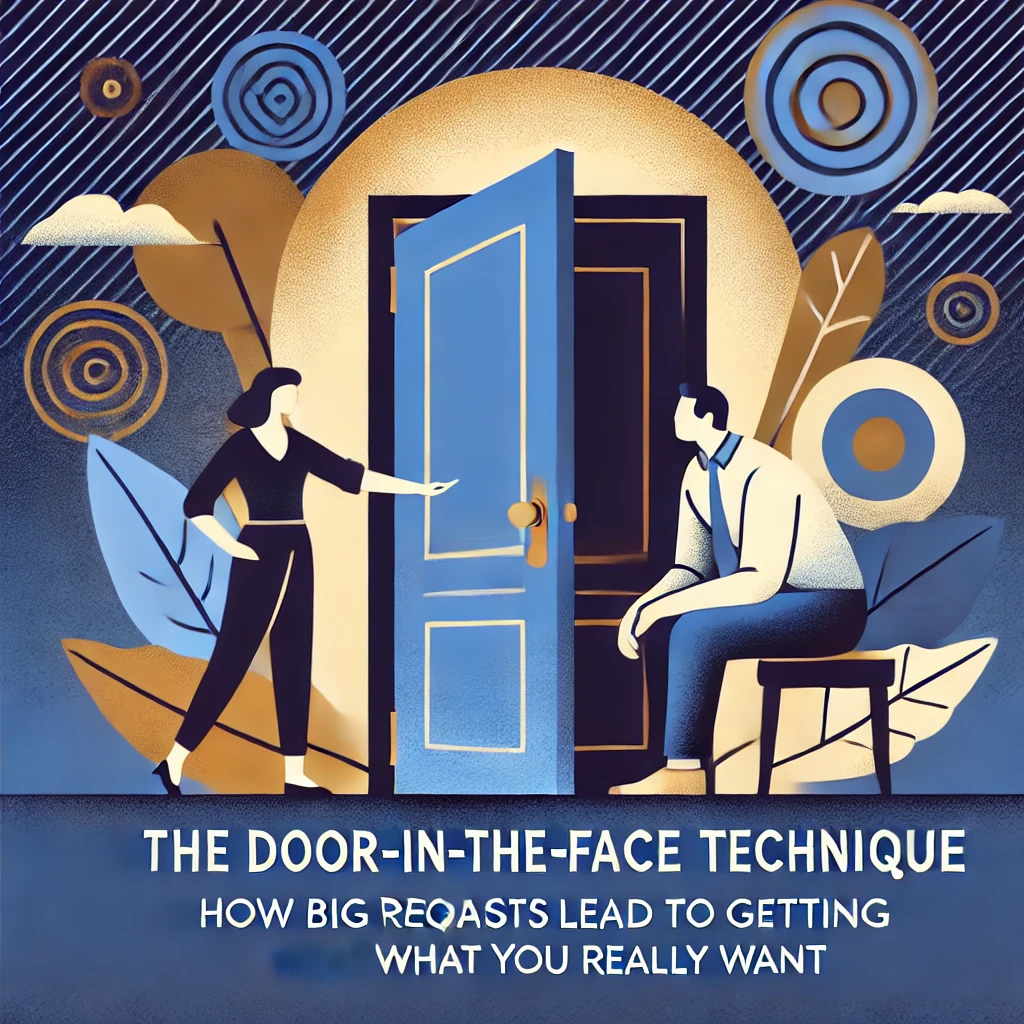We’ve all been in situations where asking for what we want feels daunting, whether it’s in our personal relationships, at work, or with friends. But what if there was a way to increase the chances of getting a “yes” by using a strategic approach to how you ask for things? That’s where the Door-in-the-Face Technique comes into play—a powerful psychological tool that involves making a large request first (one you know will likely be rejected) and then following up with a smaller, more reasonable request. This makes the smaller ask seem much more acceptable, increasing the likelihood that your partner will say yes.
While it might sound manipulative, the Door-in-the-Face Technique works because it leverages a natural human desire for compromise. When someone turns down a big request, they’re more likely to feel compelled to agree to a smaller one because it feels like they’re meeting you halfway. In relationships, this technique can help you negotiate, get your partner on board with plans, or guide conversations toward mutual understanding—all without conflict or pressure.
In this blog, we’ll explore The Door-in-the-Face Technique, how it works, and how you can use it in your relationship to influence decisions, behaviors, and outcomes. We’ll also dive into relatable examples that show how this technique can subtly guide your partner toward saying yes to the things that matter most to you.
What Is the Door-in-the-Face Technique?
The Door-in-the-Face Technique is a persuasion method that starts with a large, ambitious request—one that you expect will be declined—and follows it up with a smaller, more reasonable request. The idea is that after turning down the big request, your partner is more likely to agree to the smaller one because it seems much more reasonable by comparison.
The name comes from the image of someone metaphorically slamming the door in your face after the initial big ask, but then opening the door slightly when you make a smaller, more manageable request. This technique is rooted in the principle of reciprocity: when someone declines your first request, they feel a bit guilty or compelled to make up for it by accepting the next one.
Why Does the Door-in-the-Face Technique Work?
The Door-in-the-Face Technique works because it plays on the psychology of compromise. When your partner turns down a big request, they experience a subtle social pressure to agree to something smaller—it makes them feel like they’re being cooperative and reasonable. After all, the second request feels much easier and more manageable in comparison to the first.
In relationships, this can be incredibly useful for negotiations, getting your partner on board with your ideas, or finding a middle ground. Instead of going straight for what you want, you create a dynamic where your partner feels more inclined to meet you halfway.
How to Use the Door-in-the-Face Technique in Relationships
Let’s explore some practical examples of how you can use the Door-in-the-Face Technique to guide your partner toward agreeing to your requests.
Example 1: Planning a Weekend Trip
You’ve been wanting to plan a weekend getaway, but you know your partner might be hesitant to agree to the expense or the time commitment. Instead of going straight for your ideal trip, start by making a bigger request.
How to Use the Door-in-the-Face Technique:
Start by suggesting an even bigger, more extravagant trip—something longer or more expensive than what you actually want. “What do you think about taking a week-long vacation to that resort in Hawaii?” When they turn down the idea (as you expect), you can follow up with, “Okay, how about just a weekend at that nice cabin a few hours away?” Suddenly, the weekend trip seems much more reasonable and affordable by comparison.
Why It Works:
By starting with a larger request, you make your actual goal seem much more manageable. After turning down the Hawaii trip, your partner is more likely to agree to the weekend getaway because it feels like a compromise.
Example 2: Asking for Help with Chores
You want your partner to help out more around the house, but you’ve struggled to get them on board in the past. Instead of asking them to take on a specific task right away, you can use the Door-in-the-Face Technique to get them to agree more easily.
How to Use the Door-in-the-Face Technique:
Start by asking for a much larger commitment, like, “Could you take over all the cleaning this weekend while I relax?” When they turn it down, you can then ask for something smaller, like, “Okay, would you mind just helping out with the vacuuming instead?” This smaller request will feel much more reasonable, and your partner will be more likely to agree.
Why It Works:
The contrast between the two requests makes the second one seem far more doable, and your partner will feel like they’re being fair and helpful by agreeing to the smaller ask after turning down the big one.
Example 3: Negotiating Social Plans
You’ve been wanting to spend more time together, but your partner has been busy with their own plans. Instead of asking them to clear their entire schedule for you, use the Door-in-the-Face Technique to get them to agree to spend some time together.
How to Use the Door-in-the-Face Technique:
Start by asking for a big time commitment, like, “Do you think we could spend the whole day together this Saturday?” When they say no because of prior commitments or other reasons, follow up with, “Okay, could we at least grab dinner together in the evening?” After turning down the all-day request, the smaller ask for dinner feels much more reasonable, and they’re more likely to agree.
Why It Works:
By asking for a large block of time first, you make the smaller request for dinner feel like a fair compromise. Your partner will feel like they’re balancing their own plans with yours, and you’ll still get some quality time together.
Example 4: Getting Your Partner to Try Something New
Maybe you’ve been wanting your partner to try a new hobby or activity with you, like yoga, a cooking class, or even a creative project. But they’ve been resistant to jumping into something new. The Door-in-the-Face Technique can make it easier to get them to agree to the first step.
How to Use the Door-in-the-Face Technique:
Ask for a big commitment first, like signing up for a full six-week class. “Hey, would you be interested in signing up for this 6-week yoga course with me?” When they decline, you can follow up with a smaller request: “How about just joining me for one class this weekend to try it out?” After saying no to the larger commitment, the smaller ask feels like a much easier compromise.
Why It Works:
By framing the single class as a smaller, more manageable ask, your partner is more likely to agree. Once they try it and enjoy the experience, they may even become more open to future commitments.
Example 5: Asking for Emotional Support
You’ve been feeling like your partner hasn’t been as emotionally available lately, and you’d like more support. Instead of asking them to open up about all their feelings right away, use the Door-in-the-Face Technique to encourage more emotional engagement.
How to Use the Door-in-the-Face Technique:
Start by asking for a big, emotionally charged conversation, like, “Can we sit down and talk for an hour about how we’re both feeling in the relationship?” When they express hesitation, follow up with a smaller request: “Okay, could we at least chat for a few minutes about how we’ve been feeling this week?” This smaller request feels much more reasonable, and they’ll be more inclined to agree.
Why It Works:
By starting with a bigger emotional ask, you make the smaller conversation feel less intimidating. Your partner will feel like they’re still supporting you without the pressure of a long, deep conversation.
Why the Door-in-the-Face Technique Works in Relationships
The Door-in-the-Face Technique is effective because it creates a sense of balance and fairness. When someone says no to a large request, they feel a natural inclination to agree to the smaller one because it seems like a reasonable compromise. In relationships, this can help you get what you want without making your partner feel like they’re being forced into anything.
This technique also fosters cooperation. Your partner feels like they’re being fair and accommodating when they agree to the smaller request, which helps build trust and mutual understanding in the relationship. Instead of feeling pressured or overwhelmed, they feel like they’re contributing to a solution that works for both of you.
Tips for Using the Door-in-the-Face Technique Effectively
Here are a few key tips for making this technique work in your relationship:
- Make the First Request Big, But Not Ridiculous: The first request should be large enough that it’s likely to be declined, but not so outrageous that your partner feels like you’re being unreasonable.
- Have a Realistic Follow-Up Request: The second request should be something that feels much more manageable compared to the first. This contrast is what makes the technique work.
- Stay Positive: When your partner turns down the first request, don’t make them feel guilty or pressured. Keep the tone light and positive when you follow up with the smaller ask.
- Use It Sparingly: Like any influence technique, the Door-in-the-Face Technique works best when used in moderation. Overuse can make it feel manipulative, so use it thoughtfully and in situations where compromise is needed.
Q&A:
- What is the Door-in-the-Face technique in relationships?
Understand how making a larger request first can lead to better compromises and help achieve what you truly want in relationships. - How does the Door-in-the-Face technique work in psychology?
Learn the psychology behind why people feel inclined to say yes to smaller requests after rejecting larger ones. - How can I use the Door-in-the-Face technique with my partner?
Discover practical ways to apply this persuasion technique in everyday relationship scenarios for better communication. - What are some examples of the Door-in-the-Face technique?
Explore real-life examples of how this method can be used to negotiate chores, plan dates, and more with your partner. - Why does the Door-in-the-Face technique increase the chance of a yes?
Understand why offering a larger request first can make your partner feel more cooperative and willing to agree to a smaller ask. - Is the Door-in-the-Face technique manipulative?
Find out when using this technique can be seen as manipulative versus when it fosters mutual understanding in relationships. - Can the Door-in-the-Face technique be used to ask for more emotional support?
Learn how to use this method to encourage your partner to open up and provide more emotional support without feeling pressured. - How can I ask for help around the house without sounding demanding?
See how to apply the Door-in-the-Face technique to request household help in a way that feels fair to your partner. - What’s the difference between Door-in-the-Face and Foot-in-the-Door techniques?
Understand the difference between these two persuasion techniques and when each one is best suited for relationships. - What are some tips for using the Door-in-the-Face technique effectively?
Discover practical tips on how to make the Door-in-the-Face technique work for you in ways that respect and build trust with your partner.
Want to Master the Art of Influence in Your Relationship?
If you’re ready to take your influence skills to the next level and learn how to guide your relationship without conflict, “Mastering Him: The Secret Art of Gentle Control in Relationships” is the guide you need. In Chapter 5, you’ll dive deep into the Door-in-the-Face Technique and discover 12 other powerful strategies to subtly influence your partner’s behavior, decisions, and emotions.
Get your copy today and start mastering the art of influence in your relationship. It’s time to create the outcomes you want—one strategic request at a time.
Read more about the book: https://developmentpill.com/mastering-him-the-secret-art-of-gentle-control-in-relationships-a-guide-to-influence-hell-never-see-coming/
Book Link: https://www.amazon.com/dp/B0DKKGLZQ9
Book Link UK: https://www.amazon.co.uk/dp/B0DKKGLZQ9
You can find book Links for other regions in this post page: https://developmentpill.com/mastering-him-the-secret-art-of-gentle-control-in-relationships-a-guide-to-influence-hell-never-see-coming/



